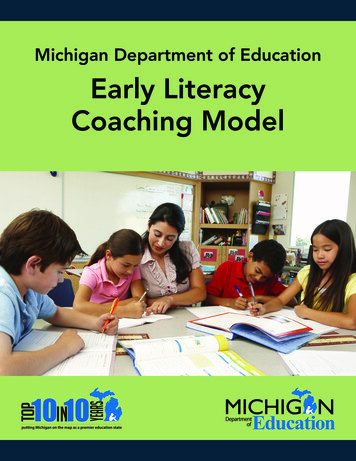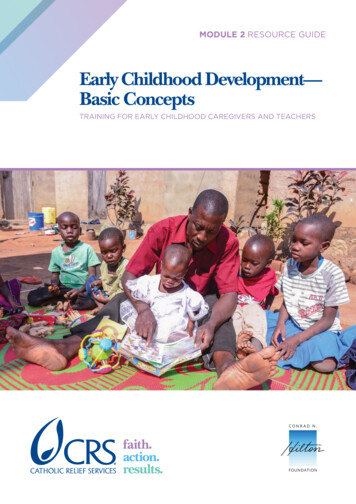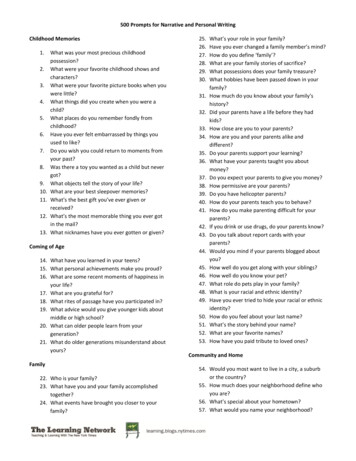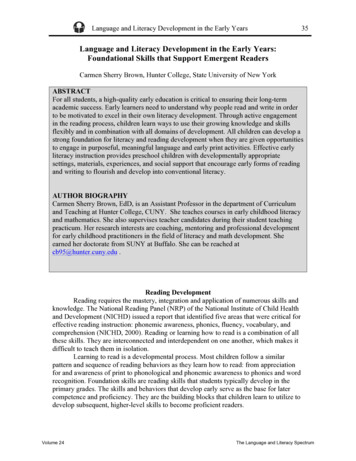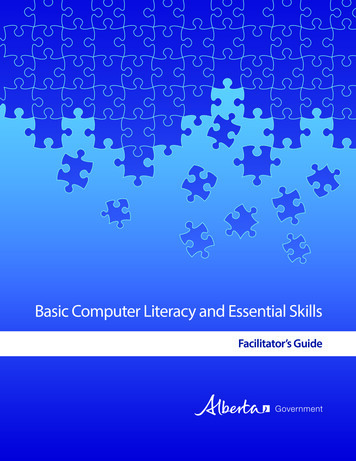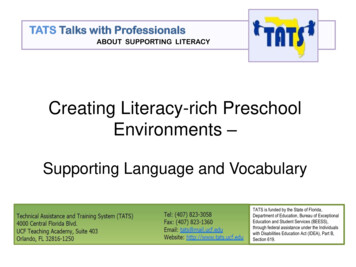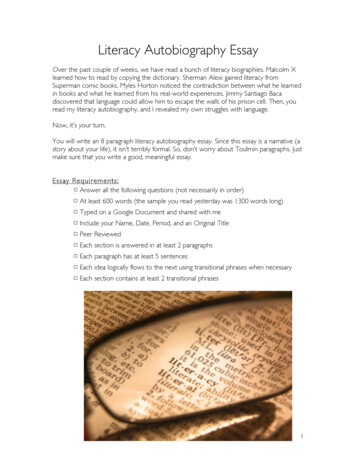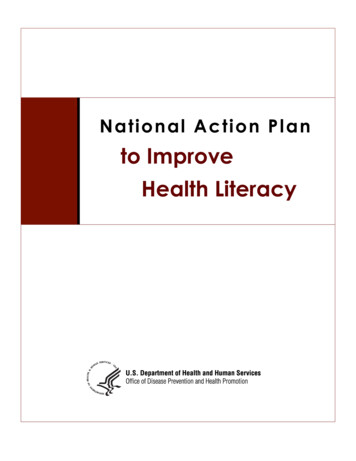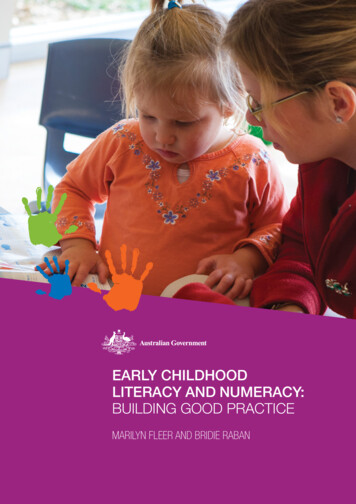
Transcription
EARLY CHILDHOODLITERACY AND NUMERACY:BUILDING GOOD PRACTICEMARILYN FLEER AND BRIDIE RABAN
ACKNOWLEDGEMENTSThis project was funded through the Australian Government Department of Education.Professors Marilyn Fleer and Bridie Raban, as co-directors, led the project with strong support from consortium membersand from Jenni Connor who developed the text for the literacy cards.Consortium members were: Monash University (Marilyn Fleer, Sue Willis and Marie Hammer), The University of Melbourne(Bridie Raban), Early Childhood Australia (Pam Cahir and Judy Radich), Curriculum Corporation (Marilyn Platek, MargeryHornibrook, Louise Poultney and Helen Smith).Advisory Committee members were: Joan Brown, Sharryn Brownlee, Priscilla Clarke, Alison Elliott, Josephine Lonergan,Gerardine Mulhearn, Beth Powell, Barbara Wellesley and Denise Williams-Kennedy.Departmental representatives were: Eileen Newmarch and Clare Fisher.Special mention must also be made of the following people who contributed significantly to the developmentof this resource: Andrea Nolan, Nina Levin, Serena Seah, Sarah Friswell, Shawna Heaton, Melanie Richmond,Dennise Rado-Lynch, Rebecca Clapp, Karrin Hotchkin, Katie Little, Katarina Hills, Yvonne Luong, Margot Boardmanand students, Wathaurong Playgroup and Monash Peninsula Early Childhood Centre.Graphic design by Claire Connelly and Kate Brennan of Early Childhood Australia.Project photographers: Andrew Sikorski, Peter Owen and Mervyn Bishop.ISBN10 1-921162-10-4 [PDF]With the exception of the Commonwealth Coat of Arms, the Department’s logo, any material protectedby a trade mark and where otherwise noted all material presented in this document is provided undera Creative Commons Attribution 3.0 Australia (http://creativecommons.org/licenses/by/3.0/au/) licence.The details of the relevant licence conditions are available on the Creative Commons website(accessible using the links provided) as is the full legal code for the CC BY 3.0 AU /au/legalcode).The document must be attributed as Early childhood literacy and numeracy: Building good practice.
CONTENTSINTRODUCTION5NEW THINKINGABOUT CHILDREN’S LEARNING6MAPPING LITERACY AND NUMERACY:ENVIRONMENTAL SCAN12MAPPING LITERACY AND NUMERACY:MAPPING INTERACTIONS17WORKSHOPS TO BUILD CHILDREN’SINTELLECTUAL LIVES24WORKSHOP 1: THINKING DEEPLY ABOUTLITERACY AND NUMERACY CONCEPTS26WORKSHOP 2: UNDERSTANDING EVERYDAYCONCEPT DEVELOPMENT IN THE HOME28WORKSHOP 3: TRANSFORMINGCHILDREN’S THINKING30CONCLUDING STATEMENT31SAMPLE CARDS – NUMERACY32SAMPLE CARDS – LITERACY35READINGS TO SUPPORT THE MATERIALIN THIS BOOK38RESOURCE BOOKS383
4
INTRODUCTIONWe know early childhood education is important and whatwe do as professionals really matters. In order to providethe best possible environments for our children, we needto be able to: look at what we do think about what we do improve what we do.In this book we provide you with different ways of lookingat your practice. New ideas for thinking about children’slearning and how you might interact differently withchildren are given. Some of the activities in this book willbe challenging, but the outcomes will be rewarding for youand for your children.WHY NOW?Governments around the world are concerned about thelevel of literacy and numeracy of young children,particularly those from the hardest-to-reach families. Earlychildhood professionals have traditionally concentratedtheir literacy and numeracy efforts on programming forchildren’s spoken development and focused on thedevelopment of number. For instance, we often plan tohelp children learn number by doing number rhymes withtoddlers. We may plan to develop literacy through talkingto infants while changing their nappies. However, morerecent research indicates that early understandings ofliteracy and numeracy are best supported when earlychildhood professionals: have a deeper knowledge of literacy and numeracy deliberately plan for activities which support beginningdevelopment in literacy and numeracy have programmes which go beyond number and thespoken word have systems for looking at their own professionalpractices seek to improve their own understandings of literacyand numeracy.PURPOSE AND STRUCTUREOF THE BOOKThis book has been designed to support you withimproving literacy and numeracy learning for youngchildren through looking at your own practice (selfappraisal). There are three sections in this book. The firstsection provides background information on literacy andnumeracy concepts. The second and third sectionsprovide different ways of thinking about literacy andnumeracy learning: Mapping tools (mapping what you have or do). Concept development (thinking about literacy andnumeracy). Workshops for developing literacy and numeracy.Example cards are also available for download. The cardsshow how literacy and numeracy can be developed throughsimple family activities and how this links to later learningat school.5
NEW THINKINGABOUT CHILDREN’S LEARNINGWhen we think about learning in the early years ofchildhood, we think about what are the concepts that weare helping young children to learn.For example, we may ask ourselves: ‘What are the literacyconcepts and what are the numeracy concepts youngchildren need to know during these early years?’When we think about concepts, we need to think aboutwhat this means at home and what this means for earlychildhood settings.Question: ‘Will the everyday concepts developed in thehome and the concepts being learned in your earlychildhood setting be the same?’New thinking about children’s learning draws our attentionto the significance of children’s everyday experiences, andthe everyday concepts they learn through theseexperiences. For example, Djeda (a toddler) helps herGrandad to feed the chickens:Grandad: Let’s give the chickens some yummy,yummy feedGrandad: Half hereDjeda: Pola ovdjeGrandad: Half over here6Children hear words like ‘half’ or ‘quarter’ every day.Having lots of experiences with splitting things into equalamounts helps children understand fractions later atschool. Fractions or ‘half’ is the numeracy concept we areworking towards, but Djeda needs lots of everydayexperiences with putting half the chicken feed in one spot,and half in another spot.What is significant for us, as early childhood professionals,is how we connect and build upon these everydayconcepts developed at home. How do we find out theeveryday concepts held by the children? What do we doin our early childhood settings to connect with theseeveryday concepts?The idea of thinking about everyday concepts andabstract—literacy and numeracy—concepts (introducedin early childhood settings) comes from the writings of LevVygotsky (see reference list) and forms the basis of thisbook. We will introduce you to the details of these newideas through the pages of this book.
WHAT DO WE MEAN BYNUMERACY CONCEPTS?When we talk about numeracy concepts we think aboutmore than just number. We think about the broad areas ofmeasurement, about spatial knowledge and the manydifferent aspects of number.MEASUREMENTExploring measurement concepts can look like this whenyou are interacting with a child:Early childhood professional: ‘Let’s wipe the table together.’(Using sponges or paper towel the children wipe the table.)Early childhood professional: ‘Did you wipe to the edge?We covered the whole area!’When we talk about ‘edge’, ‘side’, ‘top’ or ‘bottom’,children are learning about area. Children often don’tthink about area. Helping children pay attention to it helpsthem later on when they will measure these surfaces andmake comparisons.7
SPATIAL KNOWLEDGEYoung children already have some spatial knowledgethat we can build upon in our programmes. For example,when making roti at home, Ashraf and his mum had thefollowing conversation:Ashraf: ‘Look what I made.’Mum: ‘It’s curved like a raindrop shape.’Using everyday words to describe shapes such as ‘araindrop’, ‘egg shape’, ‘curved’ and ‘round’ are importantfor helping children understand shape.Over time children will use words such as ‘triangle’,‘square’ and ‘circle’. These words help children to talkabout the shapes in their environment. Noticing andstudying shape is important for learning geometry laterat school.8
NUMERACY CONCEPTSA summary of some important numeracy concepts is shown below:‘Straight’, ‘curved’ and ‘bent’ are about shape‘Sharing’ is about divisionUsing everyday words to describe shape such as ‘araindrop’, ‘egg shape’, ‘curved’ and ‘round’ areimportant for helping children understand shape.Children will share by saying ‘one for you’ and ‘one foryou’ until nothing is left.Over time children will use words such as ‘triangle’,‘square’ and ‘circle’. These words help children to talkabout shapes in their environment.Later children will learn that sharing is about division andwill know what to do with the ‘left over’.Noticing and studying shape is important for learninggeometry later.‘Upside down’ is about position and direction‘High’ and ‘low’ are measurementsPosition (where something is) and direction (where theygo) are key ideas in mathematics.All of these are comparisons. Later children will learn touse centimetres (cm), kilograms (kg), degrees etc. tomake comparisons.‘Grouping things together’ is about noticing ifsomething is the same or different‘Up’, ‘down’ and ‘next to’ are about positionLots of experiences with ‘same’ and ‘different’ helpchildren later on with describing how something maybe different (e.g. has three more), rather than just howthings look.Children learn that there are words (e.g. upside down,next to, behind) which describe position.‘Big’ and ‘little’ are about measurement‘Heavy’ and ‘light’ are about massThese words are important for learning aboutmeasurement. Later, when children are older, theyuse centimetres (cm), kilograms (kg) and degrees tomeasure and compare more accurately or to find out‘how much more’.When children are lifting and carrying things they will talkabout ‘heavy and light’, and ‘big and small’. Later, theywill notice that the biggest thing is not always theheaviest or the smallest thing not always the lightest.Having lots of experience like this helps childrenunderstand about ‘mass’ (how dense something is).‘Sorting things’ is about classifying‘Full’ and ‘empty’ are about measurementWhen we unpack the shopping, we sort things as we putthem away. Early on, children sort by what is ‘the same’and ‘what is different’. They may start by sorting colourand end up sorting by size. Later, children keep using thesame sorting system (classification) and can tell you howthey sorted.Filling a measuring cup helps children think aboutmeasurement. Words such as ‘full’, ‘half a cup’ and‘empty’ help children pay attention to measurement.‘Half here! Half over there!’ is about fractions‘Top’ and ‘edge’ are about areaChildren hear words like ‘half’ or ‘quarter’ every day.When we talk about ‘edge’, ‘top’ and ‘bottom’, we canhelp children learn about area. Children often don’t thinkabout area. Helping children pay attention to it helpsthem later on when they will measure these surfacesand make comparisons.Having lots of experiences with splitting things into equalamounts helps children understand fractions later.Later children will learn that measuring how much isin a cup is about volume and will use words such as‘litres’ or ‘millilitres’.9
WHAT DO WE MEAN BYLITERACY CONCEPTS?Long before a child utters their first word, parents/earlychildhood professionals and children begin to communicate.Their first communications take on the form of gesturesinitiated by the adults. Parents and early childhoodprofessionals take a leading role in a child’s languagedevelopment by mainly: talking to young children about the here and now being selective about the words they use encouraging children to take turns in a conversation altering the way they say things, such as slowing down,or in the usage of short, simple sentences.Children’s language and literacy development takes placein everyday activities accompanied by interesting talk withlots of new vocabulary words. Although the developmentof literacy skills is different from the development oflanguage, it is inter-related.Literacy is about more than knowing letters and readingsome words. In the early stages, we would be looking forevidence of young children showing that they are aware ofliteracy in their home and in the community in which they10live. Do they respond to print material that enters thehome like junk mail, letters and postcards, bills and otheradvertising materials? Do they respond to shop signs andprinted material on cartons and other packaging in thesupermarket? Do they know when they pass McDonald’sor the petrol station?Young children can be responsive to the purposes ofdifferent forms of print, for instance, a list for shopping, rulesto play a game, a calendar, bank books or Pokémon cards.They can show their understanding of the links betweenwhat they experience and what they say and what iswritten down through such activities as telling a story thatgets written and ‘read’, following a recipe for making ameal, giving and writing directions for someone to visit, andwriting captions to family photographs that can be re-read.From these experiences, the young child learns that printis ‘read’ one page at a time, from left to right and from topto bottom of the page.They can also learn to recognise their own name and learnsome letters through this recognition.
LITERACY CONCEPTSA summary of some important literacy concepts is shown below:Sharing books is about beginning readingLooking at ‘signs’ and ‘logos’ is about readingTurning one page at a time is a fundamental concept forinteracting with books and learned very soon withexperience and opportunity.Children can recognise shop signs, petrol station logosand other frequently seen signs in the community.Playing with rhymes is about learning word and lettersounds‘Telling’ stories is about story structureChildren enjoy joining in songs and the rhymes give them asense of the patterns of language.Telling stories gives a sense of the sequence ofevents and encapsulates a beginning, middle andend to events.Pretend reading is real readingPlaying word games is about learning the patternsof soundsPicture books give children opportunities to ‘read’ storiesfrom the pictures and turn one page at a time to get thesequence of events.Playing with rhyming words, playing ‘I spy’ and othergames with words sensitise children to the patternsof sounds in the language.Reading advertising is about thinking critically aboutprintRe-enacting or re-telling a story is aboutremembering the sequenceMulling over junk mail and catalogues gives childrenthe sense of being a reader as they take meanings fromthe pages.This requires children to remember the sequenceof events and capture the beginning, middle andend of the action from a story they have heard reador told aloud.Drawing and scribbling lead to writingWriting means the same when it is read as whenwe wrote itChildren soon learn to distinguish between their drawingsand their writing whether this is scribble, streaming, ormaking letter-like marks as they experiment with writingfor themselves.Writing materials of all kinds give children the chanceto, for instance, write messages from phoneconversations, leave messages for other peopleand learn that writing can carry meaning across timeand space.As you work your way through this book, other ideas about literacy and numeracy concepts will be shared. In sucha small publication, we cannot provide you with a full discussion of literacy and numeracy concepts. However, in thispublication we do provide some pointers about important things to think about. You may wish to draw upon theEveryday Learning Series or the Research in Practice Series which provide further information about literacy andnumeracy (e.g. Boys and Literacy Learning: Changing Perspectives, Everyday Learning about Maths and EverydayLearning About Talking).11
OVERVIEW OFSELF-ASSESSMENT ACTIVITIESAssessing the environment that we create for childrenprovides us with a lot of information about the potential forliteracy and numeracy development. The first set ofself-assessment activities will support you with thisthrough mapping your environment and your interactions: Environmental scan Mapping interactionsThe next self-assessment task concentrates on the cardsthat are shown throughout this publication and otherswhich can be downloaded from the Department ofEducation’s website (www.education.gov.au).You will find that the cards will help you think about theconcepts that children develop at home and in thecommunity and challenge you to link these to the literacyand numeracy concepts you are developing in yourprogramme. There are three workshops to support you: Workshop 1: Thinking deeply about literacy andnumeracy concepts Workshop 2: Understanding everyday conceptdevelopment in the home Workshop 3: Transforming children’s thinking12You could work your way through each of theseprofessional learning activities, or you could pick thosewhich you believe best support your development atthis point in time (going back to the others later).MAPPING LITERACY AND NUMERACY:ENVIRONMENTAL SCANAn important part of thinking about your own literacy andnumeracy programme is to map the environment that youshare with the children. The list on the next page may helpyou start on this. First, tick what you already have in yourenvironment. Only complete the second column for now.Then choose one of the environment ideas (see examplebelow). Think about the play that takes place there. Jotdown one thing you have noticed about the children’s play(see examples). Use the cards or the concept informationin the literacy and numeracy section above to help you.There are lots of ways you can use this environmentalscan—you may decide to use it as it is, or you may simplydo the first part only.
Environment:(literacy and numeracy)What have you noticed aboutchildren’s play? What is the everydayconcept being developed?Why do we do this (use cards/concepts to help you)? What isthe literacy or numeracy concept?Do you have scales orbalancing beamsavailable for children inthe block corner, outside,in the home corner etc.?(example)‘Heavy’ and ‘light’ are about mass.Toddlers are in the sandpit and beginmoving some of the play materialaround:Lots of experience with measuringhow much something weighshelps children notice that thebiggest thing is not always theheaviest or the smallest thing notalways the lightest. This helpschildren understand about ‘mass’(how dense something is).CheckedChild: ‘Is this too heavy for you?’I notice they use the words ‘heavy’and ‘light’.I notice that we don’t have a way ofmeasuring ‘how heavy something is’available for the children.Do you have clipboards,pens and paper in thedramatic play setting?(example)Children write notes and make markswhilst answering a toy telephone:Child: ‘What time would you likeyour appointment?’I notice that when I have thesetools available for children theyincorporate more literacy and numeracyinto their play.Drawing and scribbling lead towriting.By writing or drawing their ideas,children begin to pay attention tousing common symbols, so otherscan read what they wrote. They arealso learning that keeping recordsof things that happen helps toremember them.‘What time is it?’ is aboutmeasurement.Having a play clock helps childrenuse the measurement languageof time.Do you have a range ofshapes available forchildren to use (e.g.dramatic area, block area,painting paper, collage,window crystals etc.)?‘Straight’, ‘curved’ and ‘bent’ areabout shape.Do you provide spaceswhere individual/smallgroup number gamescan take place?‘How many’ is aboutunderstanding number.Do you have playmaterials in the homecorner, such as plasticcakes (which are inequal parts) or containersof beads, animals etc.for children to sharewhen playing?‘Sharing’ is about division.13
Environment:(literacy and numeracy)What have you noticed aboutchildren’s play? What is the everydayconcept being developed?Why do we do this (use cards/concepts to help you)? What isthe literacy or numeracy concept?Do you have materials forsetting up a shoppingcentre or library or otherreal-life experience wherechildren need to sortthings (not just packing upregular centre materials)?‘Sorting things’ is about classifying.Do you have a selectionof bags with books (e.g.Titch [Hutchins, 1971])and props, such as atape measure, ruler (canalso include measuringcups and spoons, coins,clocks, watches etc.)?‘Big’ and ‘little’ are aboutmeasurement.Do you have print invarious forms around thewalls of the room (e.g.notices, posters, labels,alphabet, children’snames, number charts)?Looking at ‘signs’ and ‘words’ isabout reading.Do you display children’swork with writtencaptions underneath?Looking at ‘signs’ and ‘words’ isabout reading.Do you make writing andmeasurement implementsalways available andeasily accessible forchildren to use (e.g.writing table, scales, tapemeasures, calculators)?Drawing and scribbling leadto writing.Do you include a‘signing-in’ book forchildren as well asparents, and have a clockclose by so children canwrite down the time?Messages can be sent from oneplace to another.Do you provide spaceswhere reading, writing,drawing and numbergames can take place?Reading helps us get things done.14‘Full’ and ‘empty’ are aboutmeasurement. We can alsomeasure time, area and money.They notice that labels tell themabout the objects and capture theirnames through labels. Having theirname on things tells them wheretheir belongings go.Children quickly learn to write theirname in the book or on a list as theysee their parents doing this.
Environment:(literacy and numeracy)What have you noticed aboutchildren’s play? What is the everydayconcept being developed?Why do we do this (use cards/concepts to help you)? What isthe literacy or numeracy concept?Do you incorporate acomputer area foreveryday use?Messages can be sent from oneplace to another.Do you have a collectionof charts, posters, playingcards, games withspinners, dice, egg timers,stopwatches etc.?Literacy and numeracy tools givechildren more and different types ofopportunities for talking and playingwith numbers and words.Do you have a collectionof technologies (TV,telephones, faxes, emails,internet, mobile phonesetc.) available?Talking about TV helpschildren learn.Do you provide everydayprint materials and drawchildren’s attention totheir purpose?Learning to read carefullytakes time.Do you have displays inother languages?You can’t read too many stories.Do you have access toalphabet books andbooks about numbers?Numbers are about how much,how long and how many.Using email or sending letters isabout learning that written languagecan carry a message. In talkingabout what appears on screen,children are learning that symbolsmean something particular and canbe re-arranged and placed inparticular locations using thekeyboard and mouse.Letters are about reading.Others you have?15
What do you now know about your setting that you didn’t know before?Your ideas:When English is a second language, adults read stories in their first language with children.16
MAPPING LITERACY AND NUMERACY:MAPPING INTERACTIONSResearch has shown that there are many differentways that adults interact with children when supportinglearning. The most common approach to adult–childinteraction is scaffolding.When you think about scaffolding children’s literacyand numeracy concepts, how do you interact?SCAFFOLDING Do you plan experiences beyond what the childrencan do on their own? In these experiences, do thechildren do what they can and you do the rest(shared)? For example, helping you read the recipewhen cooking.Scaffolding, in its simplest form, refers to the way an adultsupports learning. The adult can take on three differentroles during learning. The adult may model concepts tochildren. The adult may work together with a child onsomething, with the child doing what they can and theadult doing the rest. Or the adult may encourage the childto do or demonstrate the concept on their own. The adultwill do this if they feel confident that the child alreadyknows the concept or can do the task without support. Do you model the concepts at all? For example,are the literacy and numeracy words spoken aboutin your early childhood setting (modelled)? Do you actively observe children’s literacy andnumeracy development and note when childrenhave attained concepts (rather than just tasks)?For example, when Yukiko wants to write her name onher work, she may write the initial letter and the earlychildhood professional writes the remaining letters(shared). James on the other hand, needs the earlychildhood professional to write his whole name andmodel this process to him (modelled), whilst Kiana canwrite her name by herself (independent).17
NUMERACYBelow are literacy and numeracy concepts—go through each and create an example of your interaction for each level.Examples are shown. Fill in the remainder.Supporting ependent‘1, 2, 3, 4, 5’ is aboutnumber patterns.(example)(example)(example)When I am modelling, Ising/say lots of numberrhymes and songs (upto five; up to 10; up to20; up to 30).When I know a child cansing up to five, I will letthem do this part, and Iwill do the nextsequence of numbers(e.g. up to 10).When I feel confident that a childknows the number sequence, Iwill encourage them to lead thegroup in the rhyme or song andwill ask them to predict whatnumbers come after 10 or 20.When I know an olderinfant is confident in thecounting routine, I willsay ‘one’, ‘two’ and thenwait to allow the infant tosay ‘three’.When I feel confident that anolder infant or toddler knows thenumber order to three, I will invitethem to recite it.There are patterns in theway we say numbers andthey help children toremember their order.When I am modelling, Imay say the numbernames up to three whenI am about to pick up aninfant from the changetable.Grouping things isabout counting.Numbers are about ‘howmuch’, ‘how long’ and‘how many’.‘More’ and ‘less’ areabout comparing things.‘Half here! Half overthere!’ is about fractions.18
Supporting ependent‘Upside down’ is aboutposition and direction.‘High’ and ‘low’ aremeasurements.‘Grouping things together’is about noticing ifsomething is the sameor different.‘Up’, ’down’ and ‘next to’are about position.‘Big’ and ‘little’ areabout measurement.‘Top’ and ‘edge’ areabout area.19
Supporting children:(Interactions/Modelling)‘Straight’, ‘curved’ and‘bent’ are about shape.‘Heavy’ and ‘light’ areabout mass.‘Square’, ‘triangle’,‘straight’ and ‘bent’ areabout shape.‘Sharing’ is about division.‘Full’ and ‘empty’ areabout measurement.‘Sorting things’ is aboutclassifying.20ModelledSharedIndependent
LITERACYSupporting ependentSharing books is beginning reading.(example)(example)(example)Learning how a book works and thatreading is fun, is important for learningto read.When I am modelling, Ishow the children thefront of the book andpoint to the words as Iread them.When I know childrenknow some of thewords, I ask thechildren to show mewhere to start reading.When I am confidentthe children know howa book ‘works’ andhow the words tell thestory, I invite them tobegin a familiar storyfor me from thepictures.Print goes one page at a time and fromleft to right.Pointing to the print as I turn the pagesand read a story will help to reinforce forthe children the way print works—oneline at a time, left to right, top to bottomof the page.Making lists is useful for writing.Writing means the same when it is readas when we wrote it.Knowing what is written down can be‘read’ again is about the permanenceof literacy.Playing with rhymes teaches childrenabout sounds.21
Supporting children:(Interactions/Modelling)Drawing and scribbling lead to writing.Reading gives us information.Pretend reading is real reading.Signs and words are all around us.Watching and listening teacheslanguage.Describing things and grouping themdevelops the language of classifying.22ModelledSharedIndependent
Supporting ependentYou can’t read too many stories.Reading advertising takes care.Talking about TV helps children learn.We can tell stories in lots of ways.Reading helps us get things done.Messages can be sent from one placeto another.23
WORKSHOPS TO BUILD CHILDREN’SINTELLECTUAL LIVESThe purpose of the workshops is to enable colleagues tocome together and to think about their programmes withrespect to literacy and numeracy development. Theseworkshops should be facilitated by the centre director orsome other person holding a leadership position. Workshop 1: Thinking deeply about literacy andnumeracy concepts Workshop 2: Understanding everyday conceptdevelopment in the home Workshop 3: Transforming children’s thinkingAMELIA’S TRANSFORMATIONAmelia’s everyday practice was transformed because shehad learned an important abstract concept about howto control the direction of her bike. The abstract conceptwas consciously held, and allowed her to change hereveryday practice.Children in their home and community have developed aseries of everyday concepts that help them make sense oftheir everyday lives. These everyday concepts are part oftheir everyday practice. However, in early childhood settings,we develop abstract concepts that help children transformtheir everyday experience—as happened to Amelia.THEORETICAL STORYAmelia at four years of age was learning to ride her newbike. Jess, her mother, took her regularly to thecommunity oval for bike riding practice. On the oval werefour poles. On each occasion she managed to hit one ofthe four poles. Ameli
workshops to build children's intellectual lives 24 workshop 1: thinking deeply about literacy and numeracy concepts 26 workshop 2: understanding everyday concept development in the home 28 workshop 3: transforming children's thinking 30 concluding statement 31 sample cards - numeracy 32 sample cards - literacy 35
